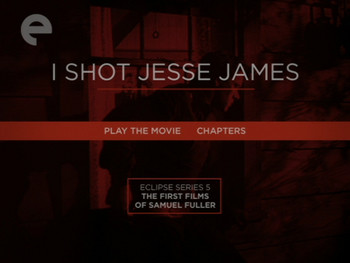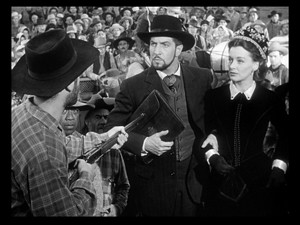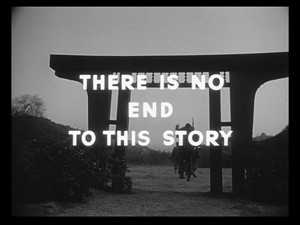
This past July at Comic-Con International, I happened to be at my publisher's table when a kid came up and asked me when a particular cartoonist would be signing. I told him the time and said, "You'll recognize him right away. He looks like he draws."
I wasn't being facetious. A lot of cartoonists have a certain physical quality that comes through in their drawing style, particularly in how they design characters (they are their own most readily available model, after all). It's weirdly like how owners and pets often resemble one another, and in the case of film directors, how they live their lives and present themselves often make them seem like they've stepped out of one of their own pictures. Quentin Tarantino, an admirer of Samuel Fuller and a participant in the documentary about his hero The Typewriter, the Rifle, and the Movie Camera, is hyper and rarely stops talking when you see him "being himself." Likewise, Jean-Luc Godard, who cast Fuller in his 1965 flick Pierrot le fou, comes across in interviews as obtuse and irascible. Those adjectives could also be used to describe Godard's motion pictures.
Catch any footage of Fuller, including any of the many interviews in The Typewriter, the Rifle, and the Movie Camera or even his appearance in Pierrot, and you'll be confronted with a real character. He speaks bluntly, his voice gruff, but he also has a devilish lilt that suggests he knows he's got the biggest brain in the room and he's earned the right to be a smartass. It's not that he speaks in ironies, either, he's far too clear-cut for that. It's just he understands how absurd most other points of view are. As he chomps on his cigar, his confidence also suggests he's got what it takes to back up anything he says.
A Samuel Fuller motion picture has the same kind of energy, the same swagger and sense of moral values. I wouldn't say that Fuller deals in a brand of ethics where good guys wear white hats and bad guys don black ones, because his heroes aren't that far off from his rogues. What drives a Sam Fuller protagonist is his resolve, his belief in his own rightness, regardless of the odds. They are tough guys, usually living in a world that hasn't just gone soft, but has lost its head and its common sense. It gives Fuller's movies an unmistakable flavor, and it is already in evidence in his earliest efforts. The three films in The First Films of Samuel Fuller, the fifth boxed set in Criterion's Eclipse Series, may not all be equal to the quality of product the auteur would earn his reputation on, but they are still Sam Fuller through and through. Even when the talent was raw, the personality was apparent.

Fuller had been a reporter, screenwriter, and novelist when he directed his first feature in 1949. I Shot Jesse James (81 minutes) isn't the story of some great gunfight where the infamous outlaw got his comeuppance, but the tale of Robert Ford (John Ireland, Red River), a member of the James gang who shot their leader in the back in order to get a pardon from the government and marry Cynthy (Barbara Britton, The Virginian), an actress he was in love with. Only, rather than bringing him fame and comfort, the deed brought Ford ignominy. In an Old West culture obsessed with the outlaw (a truly American trait), Ford was little more than a coward. To my eye, he is almost the antithesis to a Fuller hero. Shooting Jesse James (played here by Reed Hadley) wasn't something Ford really thought he should do, hence his wavering nerve and his choice to do it when the killer was unarmed and unprepared. The negative reaction of the public puts Ford on the defensive, and though he tries to redeem himself, it never quite works because he's still trying to justify the shooting as proper.
Funny thing is, this apparently wasn't Fuller's intention. He wanted to go against the grain and try to demythologize Jesse James and treat Robert Ford sympathetically. In this goal, he's not entirely successful, and many of his choices seem counterproductive. For instance, in the opening sequence, James is seen saving Ford, who took a bullet in a botched robbery. He takes his future assassin back to his home, where James lives as a family man under a different name. Hadley's portrayal of the bank robber is neither cold-blooded nor lethal, and this makes Ireland's Robert Ford appear weak and indecisive.
Perhaps it was just first-time jitters that put Fuller off the mark, because as a whole, I Shot Jesse James doesn't quite come together. There are long gaps between the bigger dramatic beats that start to drag after a while. At other times, the story seems to jump over important plot points, using newspaper headlines or wordy exposition to fill in gaps. A subplot with one of Cynthy's admirers, John Kelley (Preston Foster, The Harvey Girls), who will end up being the lawman that confronts Ford, never really gels or takes control as the real romantic throughline. Nor does Fuller have the firm hand needed to pull off some of his tricks when he tries to convey Ford's change (having him shoot an offscreen mountain lion not only plays like a bad gag, but also makes one think he simply couldn't afford the cat on this B-picture's budget; allegedly, it was shot in ten days). This makes I Shot Jesse James a solid debut, but not necessarily an auspicious one.
(For a more recent take on the same story, see Andrew Dominik's The Assassination of Jesse James by that Coward Robert Ford.)

Where Fuller does already excel in I Shot Jesse James is in the action sequences. The opening robbery is well choreographed, and the two fistfights John Kelley gets into are shockingly physical, even brutal. Unfortunately, for his second feature, The Baron of Arizona (1950; 97 minutes), the writer/director didn't pick a subject that had a lot of fighting in it. It did, however, have a rather Fuller-esque scoundrel and an excellent lead actor to play him; yet, the man at the helm was still struggling with melodramatic story structure.
The Baron of Arizona is based on the real-life story of James Addison Reavis, who in the 1880s attempted one of the most audacious con jobs of all time: swindling the U.S. government out of the entire Arizona territory. Reavis is played by Vincent Price, who was a veteran of the industry by 1950 but hadn't yet slid into his niche as a leading man in horror films. He's already able to play devilish, however, and he is an expert at the sort of calculating schemer who would go to great lengths to pull off his plan. Reavis spent many years mastering forging techniques, camping out in a Spanish monastery in order to alter ancient records, traveling south of the border to falsify graves, and even carving a proclamation in a giant rock in the middle of the desert.
Shot in fifteen days instead of ten this time, Fuller definitely has a better handle on his material and a stronger visual sense than he had on his first feature. Reavis' office almost looks like the kind of mad scientist's lair we'd see Price occupy in later films, what with its giant maps and model trains. A lynching scene set in this room is both frightening and visually powerful, the gruesome action shown almost entirely in shadow. The actual pieces of Reavis' plans are also wonderfully detailed and engrossing. Fuller still relies on some heavy-handed storytelling to get around a lot of the more complicated matters, however. Reavis' nemesis (Hadley, once again), a government man who literally wrote the book on forgery, narrates the tale from several decades after the action, in the early 1910s when Arizona is becoming a state. His voiceover slows down the plot, which has enough going for it that Fuller should have just let it play.
The melodrama this time around comes in the form of the love story between Reavis and the Baroness Sofia (Ellen Drew), the pauper who he trumps up as the rightful heir to Arizona by decree of King Ferdinand. He doesn't tell her that he's faking the whole thing, and she doesn't tell him that she really fell in love. While some of the later scenes between them are sweet, the earlier conflict is toothless. She protests to Reavis' greed, and he gently sets her aside, and she never stops loving him. It doesn't come off as psychologically sound. Likewise, the stiffness of the costume drama too often grounds Fuller's normally rootless shooting style.
Still, for his first two pictures, Fuller was establishing himself as a man who could get the job done. He was also doing it outside of the normal studio system, working independently for the Poverty Row producer Robert L. Lippert. Fuller needed to work with a guy who was as maverick as he was--and as much of a maverick as his characters, including Reavis and in his own way, Ford, were--in order to fully blossom. For his third feature, Fuller wouldn't just write and direct, he also produced. Did I say blossom? Boy, did he ever!

For as much as I Shot Jesse James and The Baron of Arizona were middling efforts, Fuller's third film for Lippert was a bonafide classic, giving full birth to the filmmaker's no-nonsense, loose cannon mise en scene. An unflinching Korean war drama, The Steel Helmet (1951; 84 Minutes) is the first of many pictures where the director would question the government, challenge racism, and ponder the horrors of war, and he would do so with the kind of guts few others in Hollywood had.
Made in the very early days of the conflict in Korea, The Steel Helmet is a cynical take on modern warfare from the vantage point of a returning soldier who was still weary from World War II when he got sucked into this new battle. The movie opens on a shot of the helmet in question, seemingly sitting on a mound of dirt, a bullet hole distinctly visible in its upper curve. After Fuller's triple-threat credit fades from the screen, the helmet rises, revealing Sergeant Zack, played by the burly Gene Evans. Zack struggles out of a ditch, climbing over corpses, his hands tied behind his back. This is no rah-rah portrait of a man serving his country. It's hard to imagine such an image coming out of the studio system only a few years prior.
The Steel Helmet presents a grim visage of war. Zack is the last surviving member of his platoon, who were all shot after being taken prisoner. Everything is off-kilter. Zack is rescued by a young Korean orphan (William Chun) whom he nicknames Short Round, the term for a bullet that can't go the distance--not unlike the one that pierced Zack's helmet, circling around the inside and coming out under the front brim, the narrowest of misses. This seems to characterize the entirety of the American effort in this portion of the battle. The attack is meant to be deadly, but it doesn't quite hit.
Fuller is intending to make a greater point about the futility of war, particularly for a nation as divided as the U.S. The ragtag group Zack eventually joins up with include an African American medic (James Driscoll) and a Japanese American called "Buddha Head" (Richard Loo). Zack speaks to all of them, including Short Round, with little concern for social propriety. They are good enough to die with, but just barely. When the team captures a North Korean soldier (Harold Fong), the communist tries to persuade the doc and Buddha Head to defect, but it's a no go. Even as messed up as we were, we could unite under the flag to hate him.
Of course, that doesn't make war sensible. In fact, the whole concept is so lopsided, not even the sanctity of a peaceful philosophy like Buddhism can be maintained. Early in the movie, enemy soldiers pretending to pray at a shrine ambush Zack and Short Round, and the mission goal for Zack's new squad is to set up camp within a Buddhist temple. In one of his signature perverse images, Fuller shows the medic nursing the captured soldier under the gaze of the giant golden statue of Buddha, the I.V. bag hanging from the idol's large finger. The communist dies, begging for Buddha's blessing, but unable to hold on to life even in that position. God is watching, but he's letting us go about our business.
All of Fuller's trademark moves got their start in The Steel Helmet. The sharp cutting, the blunt philosophy, the snappy dialogue, and the almost screwball tangential humor--it's all in this picture. Zack is the real center of The Steel Helmet, though. He's like a living, breathing embodiment of the Fuller style. Gene Evans is gruff, hulking, and weary from the world. Even so, he soldiers on, even when it all threatens to crush him. His helmet represents the dumb luck of the righteous--or if not necessarily the righteous, the guys who can at least stay true to something. When the inexperienced Lieutenant (Steve Brodie) that Zack finds himself in the service of confronts what he perceives as Zack's misguided contempt for authority, Zack fires back with the story of the kind of leader he'd gladly follow, revealing that his issue is not with those in power, but just the stupid ones.
Which would probably put Zack right in the same pot as his maker. Samuel Fuller would never have time for the blind followers, the wishy washy, or the guys who believed in nothing. Even if there is emptiness all around you, in a Fuller narrative, you still have yourself. Likewise, put a camera in the director's hand, and he'd make a movie. That's who he is, that's what he does, and like one of his own heroes, he'd suffer just about anything to get it done.

Originally written August 14, 2007. For technical specs and special features, read the full article at DVD Talk.

No comments:
Post a Comment